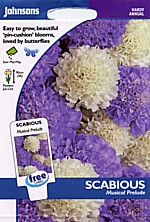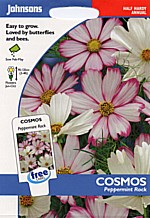JOHNSONS CUT FLOWER TRIAL PROMPTS NEW 'GROW YOUR OWN' CALL
Johnsons has published the results of a cut flower trial it conducted this summer (2011) using blooms cut from its trial ground. The primary aim was to establish which cut flowers lasted longest, the secondary aim to see if any popular treatments would extend vase life. Eleven different species of flowers regarded as suitable for cutting were monitored under seven different regimes:
1. The ‘control’ sample was placed in tap water, which remained unchanged throughout.
2. Stems were re-cut under water before being put in a vase to try and avoid an air block in the stem.
3. Water in the vase was changed every two days to limit bacteria build-up.
4. Stems were held under boiling water to kill bacteria, then put into a vase in which the water was not changed.
5. A penny and an aspirin (copper = fungicide, aspirin = acid to improve water uptake) were added to the water, which remained unchanged.
6. 1 ½ tablespoons of lemon juice, 1 tablespoon sugar, and ½ teaspoon bleach (acid to help water uptake, sugar to feed, bleach to disinfect).
7. Cut flower food, similar to that provided with flowers from a supermarket, was added to water which remained unchanged.
Zinnia elegans with a two day water change was the overall winner, lasting an impressive 24 days. Seventeen days into the test, the heads were still as good as the day they were picked. An echinacea with a two day water change came second, lasting 22 days and an echinacea with its stems re-cut under water lasted for 20 days to finish third. Equal fourth were four asters, which were the control, stems re-cut under water, ‘two day water change’, and the addition of sugar, lemon juice and bleach. Overall the most successful regime proved to be changing the water every two days. This kept the vase free of the bacteria which triggered flower decay.




Johnsons’ Leila Russell hopes the results will encourage more gardeners to grow their own flowers for cutting. “We’ve heard much about growing vegetables in the last two or three years and there is now an increasing trend for customers to grow their own cut flowers, which is equally rewarding – and very economical when compared to shop-bought flowers, especially when we consider how long they can last. A simple change of water every two days seems to beat all the so-called tricks of the trade!”, Leila says.
Johnsons seeds are available from garden centres, supermarkets and leading DIY stores throughout the UK and at www.johnsons-seeds.com
Ends.
Editor’s notes:
Flower Picking Seven flowers of each chosen variety were cut from the trial ground.
All seven stems were cut at an angle of 45º to increase the surface area of stem able to take up water.
Flowers were cut when it was relatively cool, early in the morning.
Flowers were cut when in late bud stage when they were just beginning to show some colour. Care was taken to make sure the chosen flowers were as similar as possible.
For those stems such as chrysanthemum and dianthus with multiple buds/flowers, stems were picked with the same number of buds/heads on each.
Vases Each vase contained 220ml cold tap water. Vases were thoroughly disinfected before use.
The seed testing laboratory was chosen as the location for the vases, as it is a clean environment with good, indirect light and a constant temperature.
Species tested Callistephus chinensis (aster) Chrysanthemum segetum Coreopsis grandiflora Cosmos bipinnatus Dahlia variabilis Dianthus barbatus Echinacea hybrida Gaillardia grandiflora Rudbeckia hirta Scabious atropurpurea Zinnia elegans.
Date: November 2011



